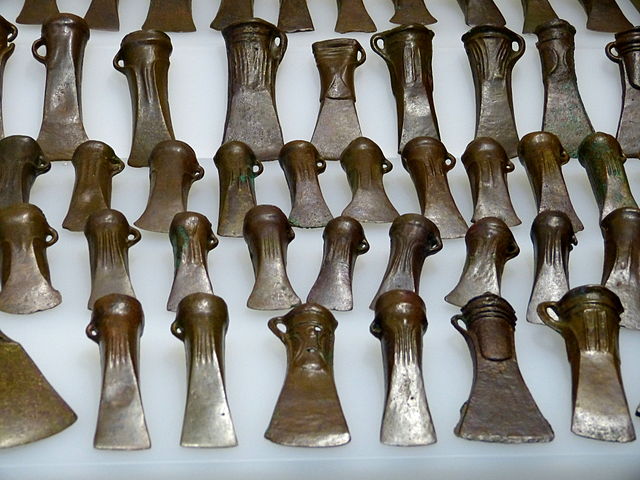Bronze is an alloy consisting primarily of copper, commonly with about 12–12.5% tin and often with the addition of other metals and sometimes non-metals, such as phosphorus, or metalloids such as arsenic or silicon. These additions produce a range of alloys that may be harder than copper alone, or have other useful properties, such as strength, ductility, or machinability.
Houmuwu ding (Chinese: 后母戊鼎; pinyin: Hòumǔwù dǐng), the heaviest Chinese ritual bronze ever found; 1300–1046 BC; National Museum of China (Beijing). This ding's name is based on the inscription in the bronze interior wall, which reads Hòumǔwù, meaning 'Queen Mother Wu'
Hoard of bronze socketed axes from the Bronze Age found in modern Germany. This was the top tool of the period, and also seems to have been used as a store of value.
Roman bronze nails with magical signs and inscriptions, 3rd-4th century AD.
Bronze bell with a visible crystallite structure.
An alloy is a mixture of chemical elements of which at least one is a metal. Unlike chemical compounds with metallic bases, an alloy will retain all the properties of a metal in the resulting material, such as electrical conductivity, ductility, opacity, and luster, but may have properties that differ from those of the pure metals, such as increased strength or hardness. In some cases, an alloy may reduce the overall cost of the material while preserving important properties. In other cases, the mixture imparts synergistic properties to the constituent metal elements such as corrosion resistance or mechanical strength.
From left to right: three alloys (beryllium copper, Inconel, steel) and three pure metals (titanium, aluminum, magnesium)
Liquid bronze, being poured into molds during casting
A brass lamp
A gate valve, made from Inconel








